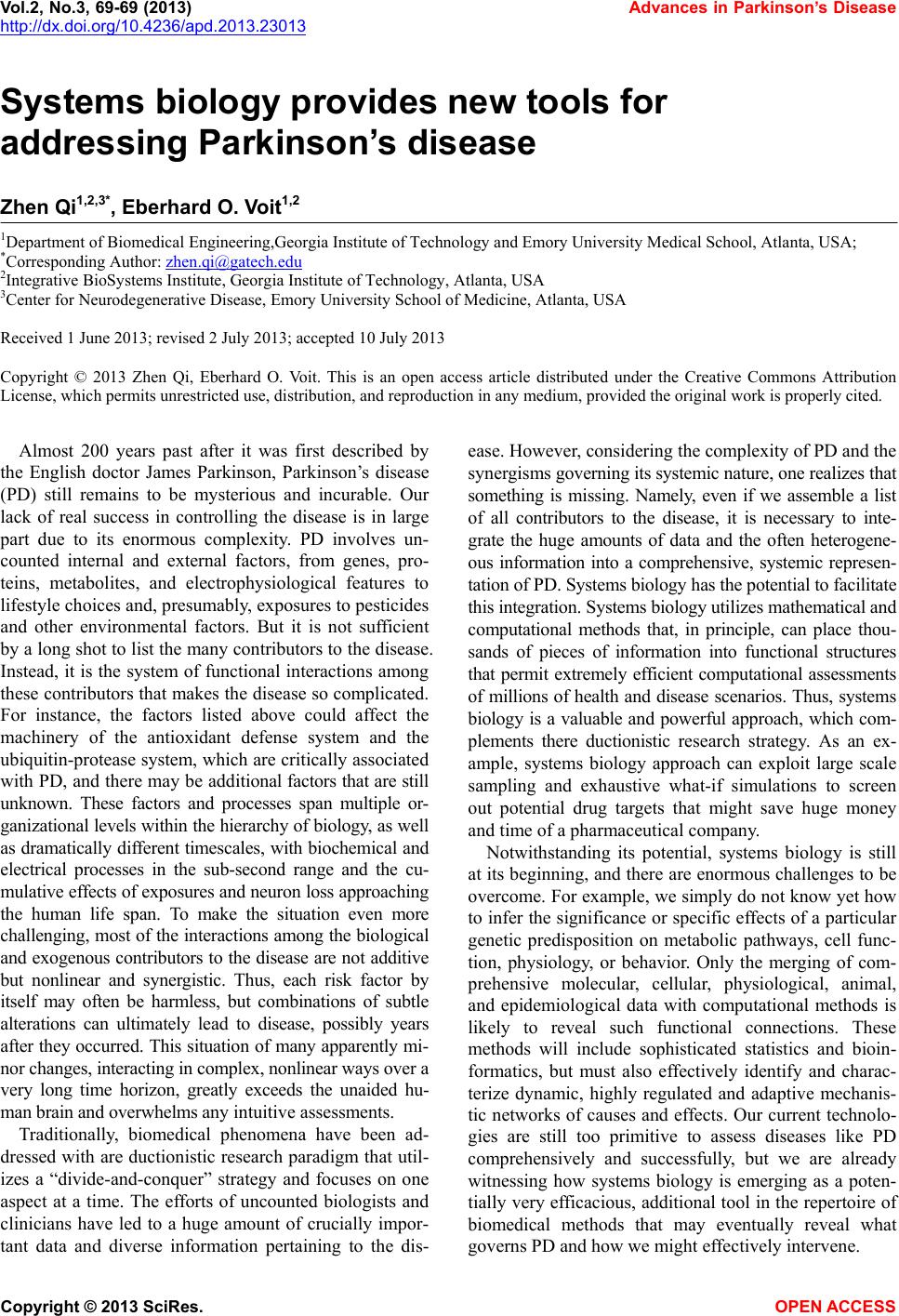
Vol.2, No.3, 69-69 (2013) Advances in Parkinson’s Disease
http://dx.doi.org/10.4236/apd.2013.23013
Systems biology provides new tools for
addressing Parkinson’s disease
Zhen Qi1,2,3*, Eberhard O. Voit1,2
1Department of Biomedical Engineering,Georgia Institute of Technology and Emory University Medical School, Atlanta, USA;
*Corresponding Author: zhen.qi@gatech.edu
2Integrative BioSystems Institute, Georgia Institute of Technology, Atlanta, USA
3Center for Neurodegenerative Disease, Emory University School of Medicine, Atlanta, USA
Received 1 June 2013; revised 2 July 2013; accepted 10 July 2013
Copyright © 2013 Zhen Qi, Eberhard O. Voit. This is an open access article distributed under the Creative Commons Attribution
License, which permits unrestricted use, distribution, and reproduction in any medium, provided the original work is properly cited.
Almost 200 years past after it was first described by
the English doctor James Parkinson, Parkinson’s disease
(PD) still remains to be mysterious and incurable. Our
lack of real success in controlling the disease is in large
part due to its enormous complexity. PD involves un-
counted internal and external factors, from genes, pro-
teins, metabolites, and electrophysiological features to
lifestyle choices and, presumably, exposures to pesticides
and other environmental factors. But it is not sufficient
by a long shot to list the many contributors to the disease.
Instead, it is the system of functional interactions among
these contributors that makes the disease so complicated.
For instance, the factors listed above could affect the
machinery of the antioxidant defense system and the
ubiquitin-protease system, which are critically associated
with PD, and there may be additional factors that are still
unknown. These factors and processes span multiple or-
ganizational levels within the hierarchy of biology, as well
as dramatically different timescales, with biochemical and
electrical processes in the sub-second range and the cu-
mulative effects of exposures and neuron loss approaching
the human life span. To make the situation even more
challenging, most of the interactions among the biological
and exogenous contributors to the disease are not additive
but nonlinear and synergistic. Thus, each risk factor by
itself may often be harmless, but combinations of subtle
alterations can ultimately lead to disease, possibly years
after they occurred. This situation of many apparently mi-
nor changes, interacting in complex, nonlinear ways over a
very long time horizon, greatly exceeds the unaided hu-
man brain and overwhelms any intuitive assessments.
Traditionally, biomedical phenomena have been ad-
dressed with are ductionistic research paradigm that util-
izes a “divide-and-conquer” strategy and focuses on one
aspect at a time. The efforts of uncounted biologists and
clinicians have led to a huge amount of crucially impor-
ant data and diverse information pertaining to the dis-
ease. However, considering the complexity of PD and the
synergisms governing its systemic nature, one realizes that
something is missing. Namely, even if we assemble a list
of all contributors to the disease, it is necessary to inte-
grate the huge amounts of data and the often heterogene-
ous information into a comprehensive, systemic represen-
tation of PD. Systems biology has the potential to facilitate
this integration. Systems biology utilizes mathematical and
computational methods that, in principle, can place thou-
sands of pieces of information into functional structures
that permit extremely efficient computational assessments
of millions of health and disease scenarios. Thus, systems
biology is a valuable and powerful approach, which com-
plements there ductionistic research strategy. As an ex-
ample, systems biology approach can exploit large scale
sampling and exhaustive what-if simulations to screen
out potential drug targets that might save huge money
and time of a pharmaceutical company.
t
Notwithstanding its potential, systems biology is still
at its beginning, and there are enormous challenges to be
overcome. For example, we simply do not know yet how
to infer the significance or specific effects of a particular
genetic predisposition on metabolic pathways, cell func-
tion, physiology, or behavior. Only the merging of com-
prehensive molecular, cellular, physiological, animal,
and epidemiological data with computational methods is
likely to reveal such functional connections. These
methods will include sophisticated statistics and bioin-
formatics, but must also effectively identify and charac-
terize dynamic, highly regulated and adaptive mechanis-
tic networks of causes and effects. Our current technolo-
gies are still too primitive to assess diseases like PD
comprehensively and successfully, but we are already
witnessing how systems biology is emerging as a poten-
tially very efficacious, additional tool in the repertoire of
biomedical methods that may eventually reveal what
governs PD and how we might effectively intervene.
Copyright © 2013 SciRes. OPEN ACCESS